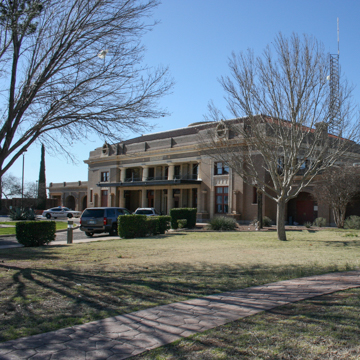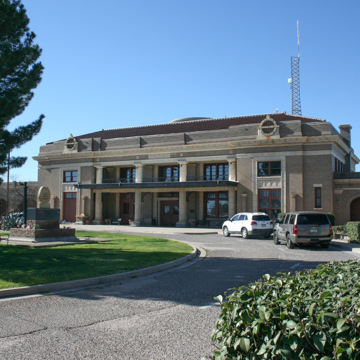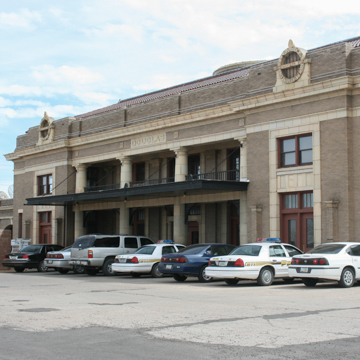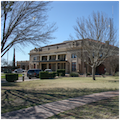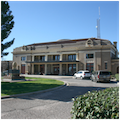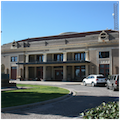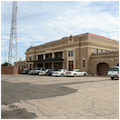You are here
Douglas Police Station
A monumental Beaux-Arts confection in the small border community of Douglas, the former El Paso and Southwestern Railroad Passenger Depot is a testament to the one-time wealth of the Arizona copper mining industry.
Douglas is located in the extreme southeastern corner of the state, across the international border from Agua Prieta, Sonora. It was founded in 1901 as a smelter town for the booming copper mines the Phelps Dodge Corporation and the Calumet and Arizona Mining Company owned in Bisbee and Mexico. The town’s existence also depended on railroads, given how critical they were to mining operations: train cars brought copper from the mines, delivered New Mexican coal and coke to the mines to fuel its smelters, and, finally, exported the copper anodes. Prior to the town’s founding, the Southern Pacific Railroad held a monopoly over the region’s rail routes, charging the mining companies exorbitant rates to access their mines. In response, Phelps Dodge purchased the fledgling Arizona and Southeastern Railroad in 1889, renaming it the El Paso and Southwestern Railroad (EP&SW). By 1902, the company had extended it from Benson through Bisbee and Douglas to its eastern terminus in El Paso. Beyond its role in mining, the EP&SW also competed with the Southern Pacific for passenger rail and freight shipping business in the Southwest. To this end, buoyed by a prosperous economy and rising copper prices, railroad executives announced plans to extend the line westward to Tucson in 1910 and to construct depots there and in Douglas. The latter town, in the midst of a boom that lasted through World War I, had emerged as the commercial and transportation center for the surrounding area. As such, it was a logical location for an upgraded passenger facility. Funded entirely by Phelps Dodge’s mining profits, the railroad and depot, located northwest of the business district at the corner of Pan American Avenue (formerly Railroad Avenue) and Fourteenth Street, formally opened on August 24, 1913, with the arrival of the EP&SW No. 6 eastbound mail train from Benson.
Wanting passenger facilities that would surpass those of Southern Pacific, the EP&SW hired Italian landscape architect Camillo Fenzi Francheschi (1889–1937) of Santa Barbara to beautify the depot grounds. Edith Douglas, the wife of Phelps Dodge general manager Walter P. Douglas (son of Dr. James Douglas, for whom the city was named), brought Francheschi to Arizona and worked closely with him on the landscaping for both the Douglas and Tucson depots. For the grounds in Douglas, covering three acres, Francheschi incorporated many of the same design elements he used in Tucson (those grounds, known as Douglas Park, were completed in 1912 and have been partially destroyed). Here, the irrigated oasis-like grounds are defined by a concrete balustrade along the south and have a circular driveway leading to the depot’s main entrance. Meandering rock-lined paths, arbors, grass, and imported trees and plants complete the scheme. The focal points were a pair of colossal concrete ornamental fountains that stood parallel to the tracks and served as a visual terminus to each end of the depot.
Designed and constructed between 1912 and 1913, the depot is a larger and more elaborate variation of its nearly identical counterpart in Tucson (1912–1913) and was the showpiece of the train line. Its Beaux-Arts monumentality reflected the upstart railroad’s effort to construct facilities that would eclipse those of its chief rival. The architect of both depots is unknown, but their plans were drawn up in the railroad’s El Paso office. (The sophistication of both depots has led some scholars to suggest the designers were Trost and Trost, the region’s leading architecture firm responsible for numerous buildings in Douglas and Tucson.) In designing the depots, the EP&SW architect produced both Beaux-Arts and Mission Revival style schemes, which the railroad sent to its New York headquarters for a final decision. Railroad officials (reportedly influenced by Edith Douglas) selected the Beaux-Arts designs apparently to make a national statement about public culture at the time of Arizona’s statehood. Rejecting the regional Mission Revival style associated with other railroads in the Southwest, the EP&SW utilized the architectural style most common for public buildings across the United States.
The two-story, buff-colored brick depot is composed of a central two-story concourse section with one-story attached porticos at its east and west ends that originally served as open-air waiting and baggage processing areas. The classical entablature and other ornamental details on the exterior are glazed terra-cotta. Both sides of the concourse section—facing the front (south) and the tracks (north)— have recessed porches with four two-story Tuscan columns that shelter the main entrances. A metal canopy projects out from the recessed porches on the north and south elevations to shelter passengers. The bays framing the recessed porches on both elevations project outward slightly and are surmounted above the entablature by large circular terra-cotta seals with raised letters spelling out “El Paso & Southwestern” and “Southwestern Route.” Above, the central concourse has a truncated hipped roof covered in clay tile and topped by a shallow dome. The attached porticos are of comparatively simple design; flat roofed and open on three sides, their walls consist of three elliptical arches divided by pilasters that rise through the parapet. In plan, the depot is roughly rectangular and organized around a three-story central rotunda with an ornate circular skylight; the latter is composed of wedge-shaped panels of stained glass. The ground floor contained waiting rooms in its east wing and an express office and baggage area in the west. On the second floor of the rotunda, four marble Corinthian columns frame a circular balcony overlooking the ground floor and support the dome. French doors lead from the second floor onto balconies in the recessed porches above the main entrances on the north and south elevations of the depot. Throughout, the interior features concrete floors, plastered walls, and dark wood trim around the doors and windows.
The depot was the focal point of passenger rail traffic along Arizona’s southeastern border during the early twentieth century, serving a steady flow of mining executives, mineworkers, residents, and visitors. Due to cash flow problems caused by a downturn in the copper industry, Phelps Dodge sold the EP&SW to the Southern Pacific in 1924 and the depot’s name changed to reflect its new ownership. (Its Tucson counterpart was shuttered entirely at this time in favor of Southern Pacific’s existing local depot.) The Douglas depot was a major stop for transcontinental troop trains during World War II, and Douglas residents established a canteen in the building to feed soldiers in transit. During the postwar years, increased popularity of automobile travel and associated decline in railroad ridership led Southern Pacific to end its passenger service to Douglas. By 1961, it had abandoned the depot and the border-hugging EP&SW line east to El Paso. In 1985, the city purchased the deteriorating depot and neglected grounds from Southern Pacific, renovating the building for use as a police station. The last railroad tracks were removed in the 1990s, but the grounds retain several elements of the original landscape, including concrete balustrades and the two monumental fountains (in need of restoration). A new addition is the visitor’s center to the north of the depot. Although the depot’s usage has changed, it remains a vital presence in the community and a reminder of the railroad’s central role in Douglas’s early development.
References
Hayostek, Cindy. Douglas. Charleston, South Carolina: Arcadia Publishing, 2009.
Jeffery, R. Brooks, “El Paso and Southwestern Railroad Depot,” Pima County, Arizona. National Register of Historic Places Registration Form, 2002. National Park Service, U.S. Department of the Interior, Washington, D.C.
Kincaid, David J., and Douglas Kupel, “El Paso and Southwestern Railroad Passenger Depot, Douglas,” Cochise County, Arizona. National Register of Historic Places Inventory-Nomination Form, 1985. National Park Service, U.S. Department of the Interior, Washington, D.C.
Nequette, Anne M., and R. Brooks Jeffery. A Guide to Tucson Architecture. Tucson: University of Arizona Press, 2002.
Potter, Janet Greenstein. Great American Railroad Stations. New York: Preservation Press, 1996.
Schwantes, Carlos A. Vision & Enterprise: Exploring the History of Phelps Dodge Corporation. Tucson: University of Arizona Press, 2000.
Writing Credits
If SAH Archipedia has been useful to you, please consider supporting it.
SAH Archipedia tells the story of the United States through its buildings, landscapes, and cities. This freely available resource empowers the public with authoritative knowledge that deepens their understanding and appreciation of the built environment. But the Society of Architectural Historians, which created SAH Archipedia with University of Virginia Press, needs your support to maintain the high-caliber research, writing, photography, cartography, editing, design, and programming that make SAH Archipedia a trusted online resource available to all who value the history of place, heritage tourism, and learning.














